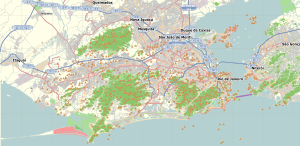Pavuna: Difference between revisions
JJMC89 bot (talk | contribs) Migrate {{Infobox settlement}} coordinates parameters to {{Coord}}, see Wikipedia:Coordinates in infoboxes |
m fix typo |
||
| Line 43: | Line 43: | ||
==History== |
==History== |
||
The place was originally inhabited by native Brazilians from several [[Tupi people|Tupi]] tribes, one of those tribes was named Upabuna, this name being the origin of the name of the Pavuna River.<ref name="nameinfo">{{cite web|url=http://www2.rio.rj.gov.br/governo/pavuna.cfm|title=Histórico|publisher=Rio de Janeiro Government|accessdate=February 27, 2011|language=Portuguese}}</ref> During the 16th century, when Brazil was a colony of Portugal, the Portuguese government brought African slaves to the place to work in the sugarcane cultivation.<ref name="nameinfo" /> In the seventeenth century, the sugarcane cultivation entered a period of |
The place was originally inhabited by native Brazilians from several [[Tupi people|Tupi]] tribes, one of those tribes was named Upabuna, this name being the origin of the name of the Pavuna River.<ref name="nameinfo">{{cite web|url=http://www2.rio.rj.gov.br/governo/pavuna.cfm|title=Histórico|publisher=Rio de Janeiro Government|accessdate=February 27, 2011|language=Portuguese}}</ref> During the 16th century, when Brazil was a colony of Portugal, the Portuguese government brought African slaves to the place to work in the sugarcane cultivation.<ref name="nameinfo" /> In the seventeenth century, the sugarcane cultivation entered a period of decadence, only recovering a century later, and then being replaced by the coffee production.<ref name="nameinfo" /> On July 23, 1981, Pavuna officially became a Rio de Janeiro neighbourhood.<ref name="foundation">{{cite web|url=http://www2.rio.rj.gov.br/smu/buscafacil/Arquivos/PDF/D3158M.pdf|title=Origem do nome Pavuna|publisher=Rio de Janeiro Government|accessdate=February 27, 2011|format=PDF|language=Portuguese}}</ref> |
||
==Etymology== |
==Etymology== |
||
Revision as of 16:02, 6 July 2019
Pavuna | |
|---|---|
Neighbourhood | |
| Coordinates: 22°49′18″S 43°20′26″W / 22.82167°S 43.34056°W | |
| Country | |
| State | Rio de Janeiro (RJ) |
| Municipality/City | Rio de Janeiro |
| Zone | North Zone |
Pavuna is a neighbourhood in the North Zone of Rio de Janeiro, Brazil. It is one of the oldest places in Rio de Janeiro city.
History
The place was originally inhabited by native Brazilians from several Tupi tribes, one of those tribes was named Upabuna, this name being the origin of the name of the Pavuna River.[1] During the 16th century, when Brazil was a colony of Portugal, the Portuguese government brought African slaves to the place to work in the sugarcane cultivation.[1] In the seventeenth century, the sugarcane cultivation entered a period of decadence, only recovering a century later, and then being replaced by the coffee production.[1] On July 23, 1981, Pavuna officially became a Rio de Janeiro neighbourhood.[2]
Etymology
Pavuna means "dark place" in the language of the local native Brazilians who inhabited the place in the past.[1]
References
- ^ a b c d "Histórico" (in Portuguese). Rio de Janeiro Government. Retrieved February 27, 2011.
- ^ "Origem do nome Pavuna" (PDF) (in Portuguese). Rio de Janeiro Government. Retrieved February 27, 2011.

